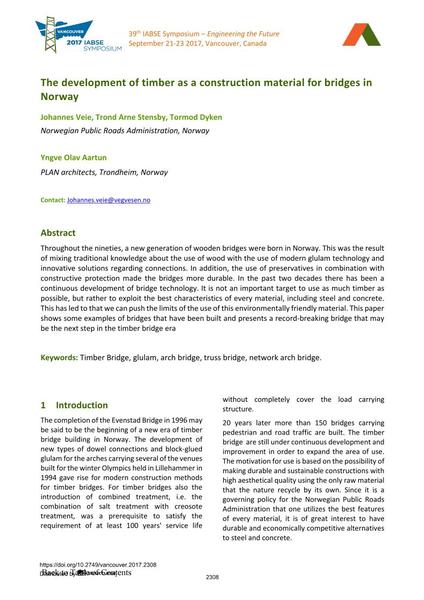The development of timber as a construction material for bridges in Norway

|
|
|||||||||||
Bibliografische Angaben
| Autor(en): |
Johannes Veie
(Norwegian Public Roads Administration, Norway)
Trond Arne Stensby (Norwegian Public Roads Administration, Norway) Tormod Dyken (Norwegian Public Roads Administration, Norway) Yngve Aartun (PLAN architects, Trondheim, Norway) |
||||
|---|---|---|---|---|---|
| Medium: | Tagungsbeitrag | ||||
| Sprache(n): | Englisch | ||||
| Tagung: | IABSE Symposium: Engineering the Future, Vancouver, Canada, 21-23 September 2017 | ||||
| Veröffentlicht in: | IABSE Symposium Vancouver 2017 | ||||
|
|||||
| Seite(n): | 2308-2313 | ||||
| Anzahl der Seiten (im PDF): | 6 | ||||
| Jahr: | 2017 | ||||
| DOI: | 10.2749/vancouver.2017.2308 | ||||
| Abstrakt: |
Throughout the nineties, a new generation of wooden bridges were born in Norway. This was the result of mixing traditional knowledge about the use of wood with the use of modern glulam technology and innovative solutions regarding connections. In addition, the use of preservatives in combination with constructive protection made the bridges more durable. In the past two decades there has been a continuous development of bridge technology. It is not an important target to use as much timber as possible, but rather to exploit the best characteristics of every material, including steel and concrete. This has led to that we can push the limits of the use of this environmentally friendly material. This paper shows some examples of bridges that have been built and presents a record-breaking bridge that may be the next step in the timber bridge era |
||||
| Stichwörter: |
Bogenbrücke Fachwerkbrücke Netzwerkbogenbrücke
|
||||
